
- Home
- India
- World
- Premium
- THE FEDERAL SPECIAL
- Analysis
- States
- Perspective
- Videos
- Sports
- Education
- Entertainment
- Elections
- Features
- Health
- Business
- Series
- In memoriam: Sheikh Mujibur Rahman
- Bishnoi's Men
- NEET TANGLE
- Economy Series
- Earth Day
- Kashmir’s Frozen Turbulence
- India@75
- The legend of Ramjanmabhoomi
- Liberalisation@30
- How to tame a dragon
- Celebrating biodiversity
- Farm Matters
- 50 days of solitude
- Bringing Migrants Home
- Budget 2020
- Jharkhand Votes
- The Federal Investigates
- The Federal Impact
- Vanishing Sand
- Gandhi @ 150
- Andhra Today
- Field report
- Operation Gulmarg
- Pandemic @1 Mn in India
- The Federal Year-End
- The Zero Year
- Science
- Brand studio
- Newsletter
- Elections 2024
- Events
What Chandrayaan 3 rover reveals about ancient craters and more

With the images captured by the Navigational Camera (NAVCAM) of the Pragyan Rover in the Chandrayaan 3 mission, Indian researchers discovered three significant findings. They identified an ancient crater, approximately 160 km wide, now hidden beneath subsequent impact craters. Further, the scientists have explained why the Chandrayaan 3 landing site is free of large boulders and marked with...
With the images captured by the Navigational Camera (NAVCAM) of the Pragyan Rover in the Chandrayaan 3 mission, Indian researchers discovered three significant findings. They identified an ancient crater, approximately 160 km wide, now hidden beneath subsequent impact craters. Further, the scientists have explained why the Chandrayaan 3 landing site is free of large boulders and marked with small crater clusters. The findings published in the recent issue of the journal Icarus, devoted to the field of Solar System studies, report that up to approximately 2,300 metres below the four legs of the Vikram, Chandrayaan 3 lander, are ejecta deposited from the South Pole Aitken basin and other impact craters.
Pockmarked Moon
On the night of March 17, 2013, astronomers at Marshal Space Flight Center's telescope facility were taken aback when they saw a startling flash of light on the Moon's surface at 17, 2013°N, 335.6698°E lat-long. They were sure that a meteorite or asteroid had crashed.
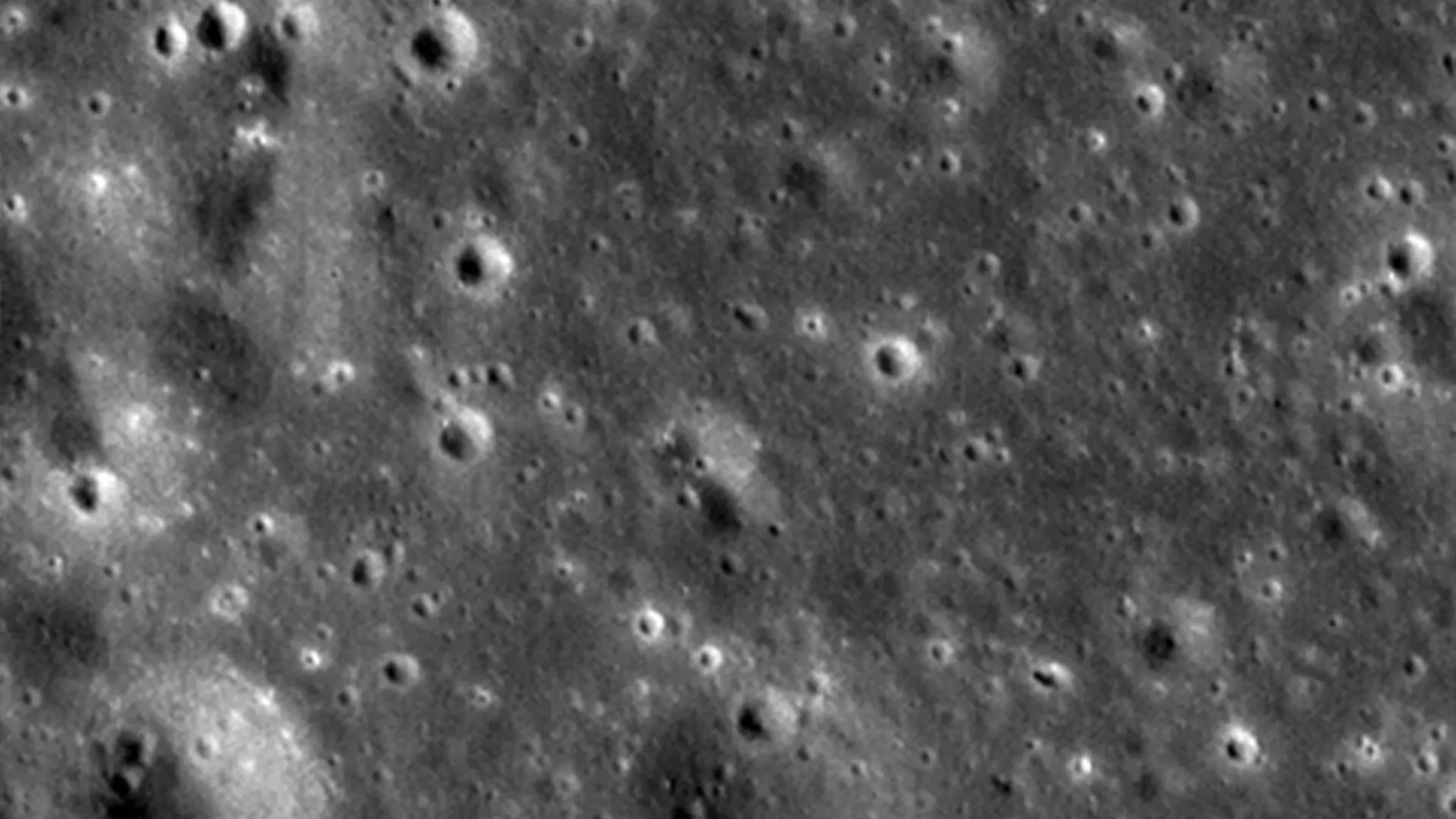
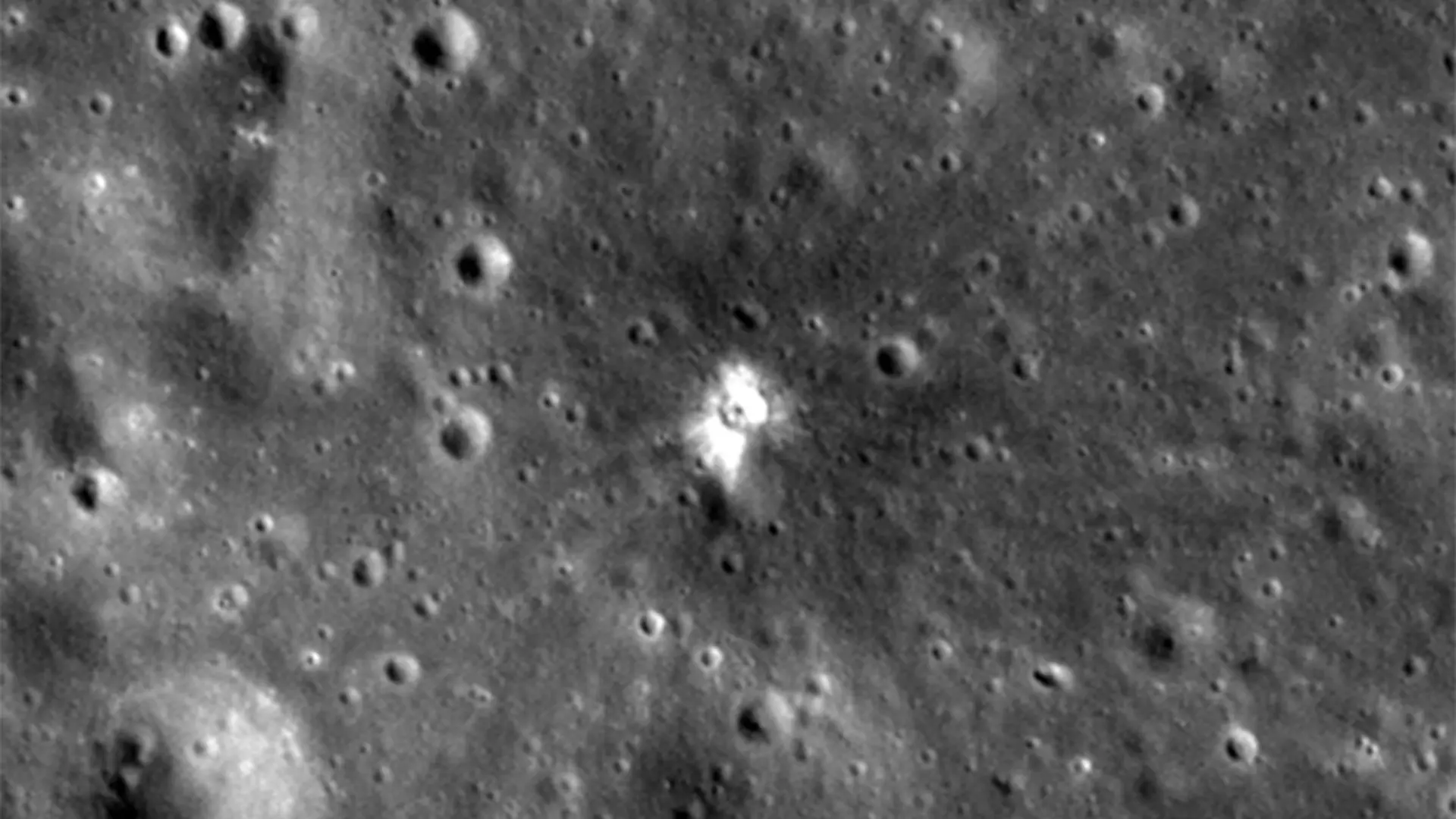
Before and after the collision: The silver-like bright spot is the impact crater. Due to constant solar radiation, the top layer of the regolith, lunar soil, is dark. The inner regolith is protected from solar radiation, and the impact ejects it and brings it to the top, thus making the fresh crater shiny.
Meteorites and tiny asteroids are leftovers of the solar system’s evolution into a core Sun surrounded by eight planets and hundreds of dwarf planets. These space rocks travel in erratic patterns and frequently collide with other solar system objects. Every year, almost 17,000 meteorites strike Earth, 6,100 of them big enough to fall to the Earth. As these space rocks pierce the atmosphere at high speeds, friction causes most of them to burn up and get vaporised.
However, because the Moon lacks an atmosphere, everything in its path slams and forms small and large craters. NASA's Lunar Impact Monitoring Program, which includes the Marshal research station, has been monitoring the Moon since 2005. Since its inception, researchers have seen over 300 flashes, most likely generated by meteor collisions. The flare seen on March 17, 2013, was 10 times brighter than previously recorded. It was clearly visible to the naked eye. Intrigued, they turned on the high-resolution camera aboard the NASA spacecraft orbiting the Moon. The NASA Lunar Reconnaissance Orbiter (LRO) spotted the telltale signs of a recently created crater shining silver. Subsequent research indicated that the crater was caused by an approximately 40-kilogram meteoroid impacting the Earth at a 90,000 km/h speed.
Even with a toy telescope, we can see hundreds of big and small craters (near-circular holes) on the Moon's surface. These bowl-like cavities result from billions of collisions with various-sized asteroids and meteoroids.
The Moon's biggest and oldest crater near its south pole is the South Pole Aitken basin. This basin, with a circumference of 2,500 km and a depth ranging from 6.2 to 8.2 km, is of particular interest to scientists. They believe it originated roughly 4.2 billion years ago when the Earth and Moon were still young. The basin's age and size make it a key area for studying the early history of the Moon and the solar system.
Face reading
Unlike Earth, the Moon is free of wind, rain, or other weathering activity that affects its surface features. As a result, once a crater forms, it causes a permanent scar on its surface. Only a later impact can partially erase and bury the prior wounds.
Craters serve as a historical record of the lunar surface's past. Scientists investigate craters' size, form, and placement to learn more about the objects that impact the Moon, how frequently they strike, and how these patterns have evolved.
When meteoroids impact the Moon, they not only create craters but also expel debris into the surrounding terrain. The size and form of the resulting crater depend on the size and speed of the impacting meteoroid. Small meteors produce simple craters, bowl-shaped depressions, elevated rims, and ejecta blanket. Larger asteroids form complicated craters with an elevated centre dome, shallow floors, and massive terraces around the edges. The rubble may be seen as long, brilliant rays spreading far from the crater. Giant asteroids develop basins wider than 300 kilometres, with upturned edges producing mountain ranges around its edges. Thus, the crater's size and form provide valuable information about the meteor's magnitude and the impact process.
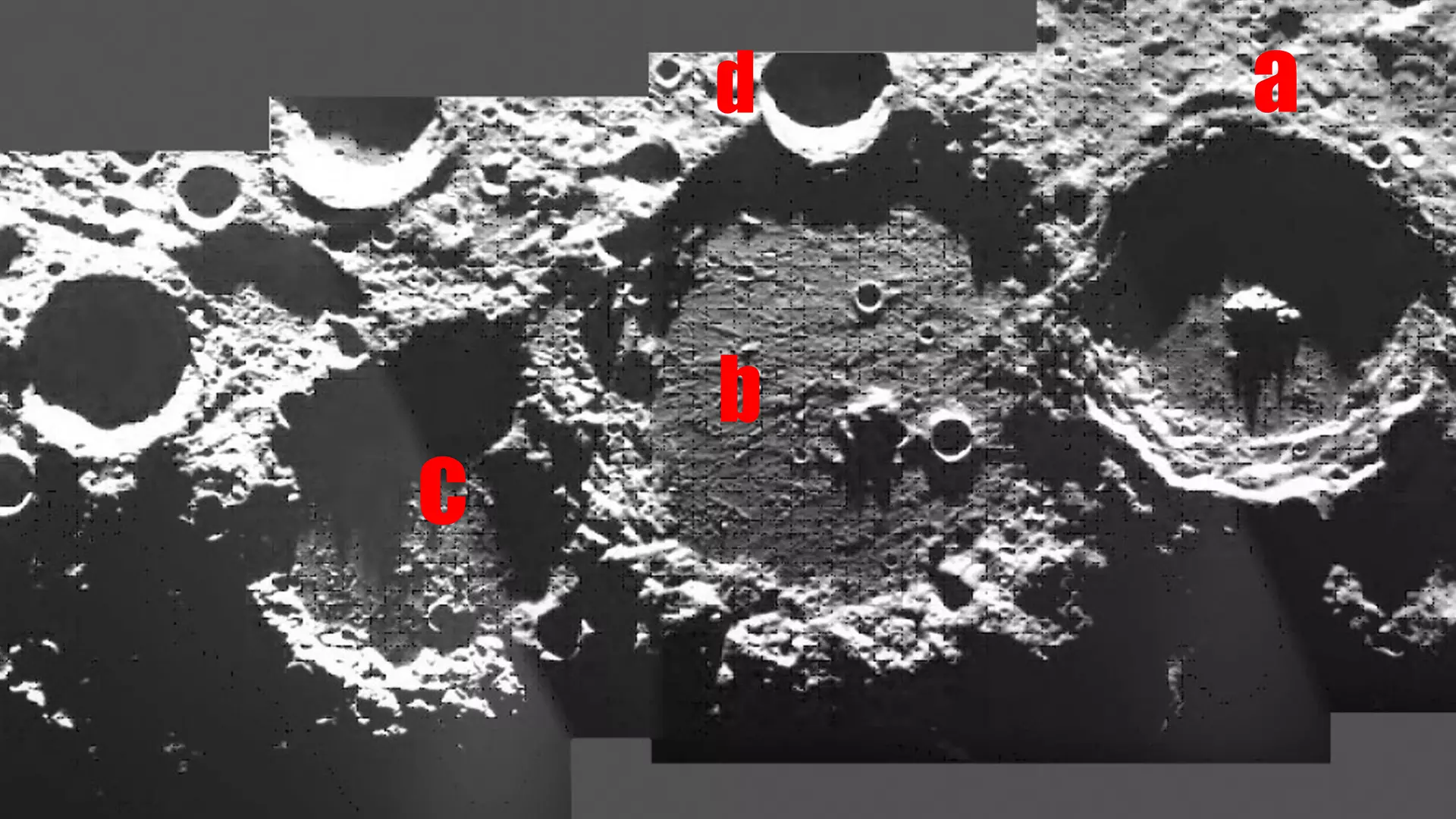
Observe the rim of a is complete while that of b is partially damaged due to a. Therefore, we can conclude that a is after b, and b is after c, but d is after b from the images.
We can establish the age of the primary crater by gauging the smaller ones within it. The older the craters, the smaller craters they encompass. Similarly, overlaid craters, two or more craters that overlap, can be utilised to establish crater ages. Naturally, the subsequent impact would damage a portion of the earlier crater's rim. From this, we can infer which of the craters is older and which is younger.
More than that meets the eyes.
Since August 2019, the Chandrayaan2 (CH2) spacecraft has been revolving around the Moon in a polar orbit at an altitude of 100 kilometres. It has an advanced Optical High-Resolution Camera (OHRC) with 0.25 meters per pixel resolution.
The researchers examined the high-resolution orbiter pictures captured by the CH2-OHRC at the CH-3 landing site. Within a 50-meter radius of the landing site, 671 craters were uncovered, ranging in size from ~0.65m to ~16m.
The CH-3's Pragyan Rover was equipped with two NAVCAMs in front. Over ten days, the Pragyan rover travelled around 100 metres from the lander, capturing numerous images of the lunar surface. The researchers spotted the craters in the NAVCAM photos. They matched and accounted for all 111 craters along the Rover's journey among the 671 at the landing site.
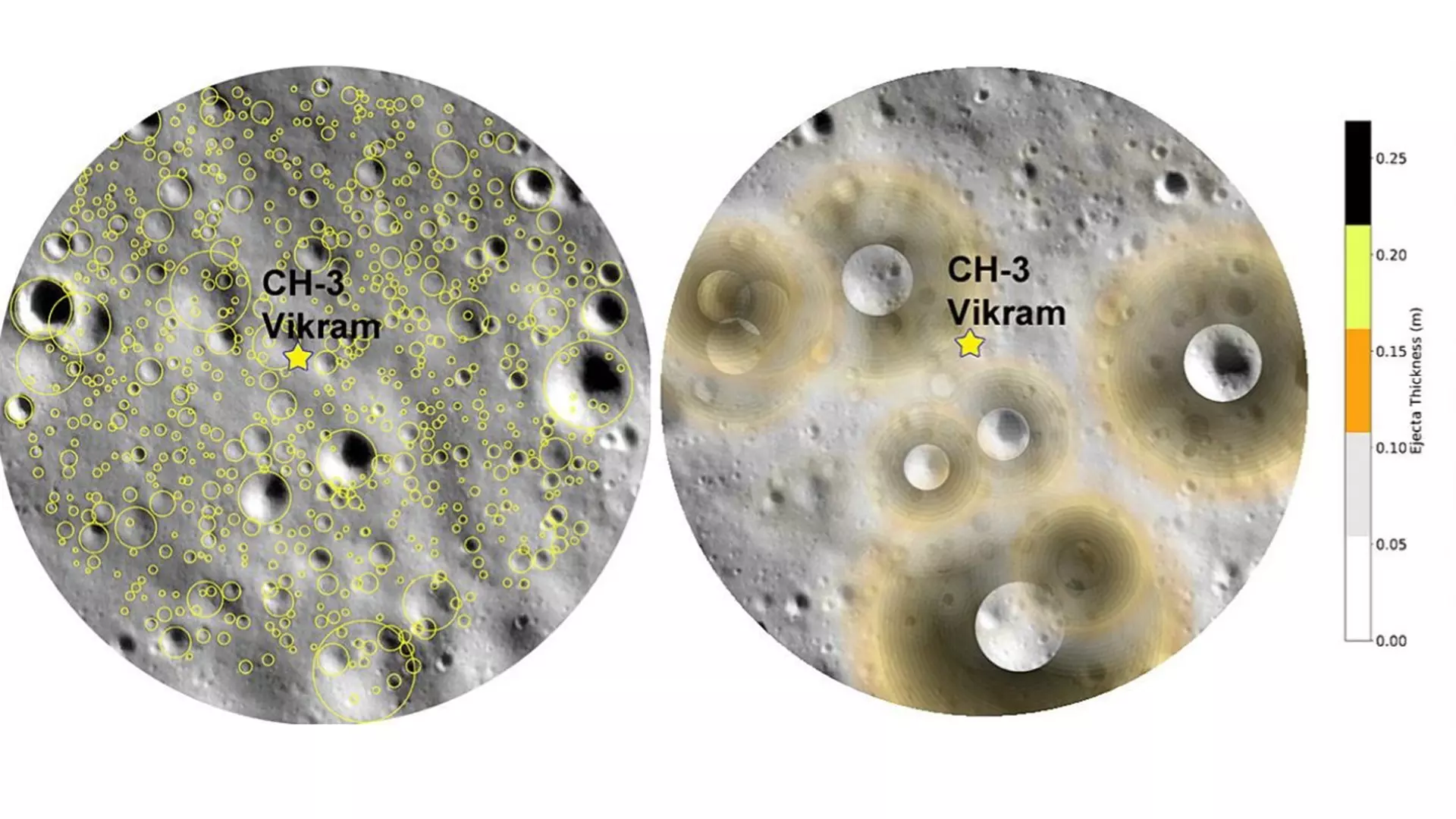
Chandrayaan 3 landing site is dotted with small and big craters, primary and secondary. The ejecta from these impacts spread over the landscape, contributing to the formation of lunar soil in the region.
However, there was an unanticipated twist. The NAVCAM close-up photographs revealed far more craters than the CH2-OHRC had identified. For example, one of the craters measuring ten meters in diameter contained at least ten smaller craters. Ultimately, the researchers identified 179 craters using the Rover's Navcam photos rather than 111 along the path of the Rover. According to the researchers, "the crater density is nearly 50% more" than in orbiter photographs. "This flux of impact craters we observed from the rover images are mostly superposed craters, small diameter, and they mostly appear in clusters, and this tends to be secondaries", they said.
Lunar soil
The soil on Earth is generated gradually by weathering and decomposition, which breaks down rocks and plant remnants. In contrast, the ongoing bombardment of big and tiny meteoroids over four billion years has generated the upper few meters of the Moon, known as lunar soil or regolith, which is made of dust and rubble. Constant micrometeorite hits pound the top layer into superfine, unconsolidated grains. With no protective magnetic field or atmosphere to stop it, the lunar surface is continually exposed to severe solar radiation, resulting in space weathering that darkens and reddens the top layer of regolith.
Except for the dirt delivered by rain, soil formation on Earth is primarily local. On the Moon, however, meteor impacts create enormous craters and scatter debris in all four directions. These ejecta fall at a distance and form a cluster of smaller secondary craters. During the collision, dirt from below is transported to the surface. Secondary craters are one of the primary sources of mixing in the top regolith layer, with one research estimating that impacts and secondary craters will thoroughly mix the top two centimetres of the regolith in around 81,000 years.

The regolith structure at the landing site is primarily the mixture of the SPA basin ejecta mixed with secondary and primary craters ejecta.
Thus, a sequence of layers of lunar regolith includes elements ejected by nearby and distant impacts, which mix with already extant regolith material through smaller impacts or secondary impacts, followed by space weathering.
Chandrayaan-3 landing site regolith
The Indian researchers discovered that the lunar regolith at the CH-3 landing site mainly comprises ejecta from the South Pole-Aitken basin, around 350 kilometres distant. The South Pole-Aitken basin was formed by a massive impact around 4.2 to 4.3 billion years ago. Materials scattered underneath the lander legs from the South Pole-Aitken basin impact are estimated to be around 1400m deep. Furthermore, ejecta deposits from nearby and distant impact basins are the second most significant contributor to the CH-3 landing site regolith. The regolith depth is estimated to be roughly 580 meters due to debris discharged from 12 basins surrounding the landing site. The landing site is bordered by many wrecked complex craters, including Manzinus, Boguslawsky, and Boussingault A. The researchers estimate that the ejecta debris from these contributed to a regolith thickness of around 90 m.
“Overall, the Chandrayaan-3 landing site host South Pole-Aitken basin ejecta along with other impact crater ejecta that could be mixed or reworked or redistributed by the simple and secondary craters," concluded the researchers.
The study found that the landing site has a comparatively higher number of smaller craters, implying that ejecta from the South Pole-Aitken basin and other impacts would have completely churned and thoroughly mixed the top 0.5 meters of lunar regolith at the landing site. The high incidence of secondary impacts explains why the Pragyan rover photos revealed the landing site to be free of rocks larger than one meter during its ~103-meter travel path.
Ancient crater
The researchers zoomed out to examine the wider region surrounding the landing spot. They identified a roughly 160 km wide near-semi-circular structure over the CH-3 landing zone.
Younger impacts frequently erode older craters. The rims collapse due to direct or secondary collisions, and the crater is eventually buried in ejecta deposition from later impacts. The ejecta from the South Pole-Aitken impact initially filled the ancient crater, and then portions of the crater walls fell and settled on the floor, eventually burying the old crater. If correct, this ancient crater predates even the earliest South Pole-Aitken.
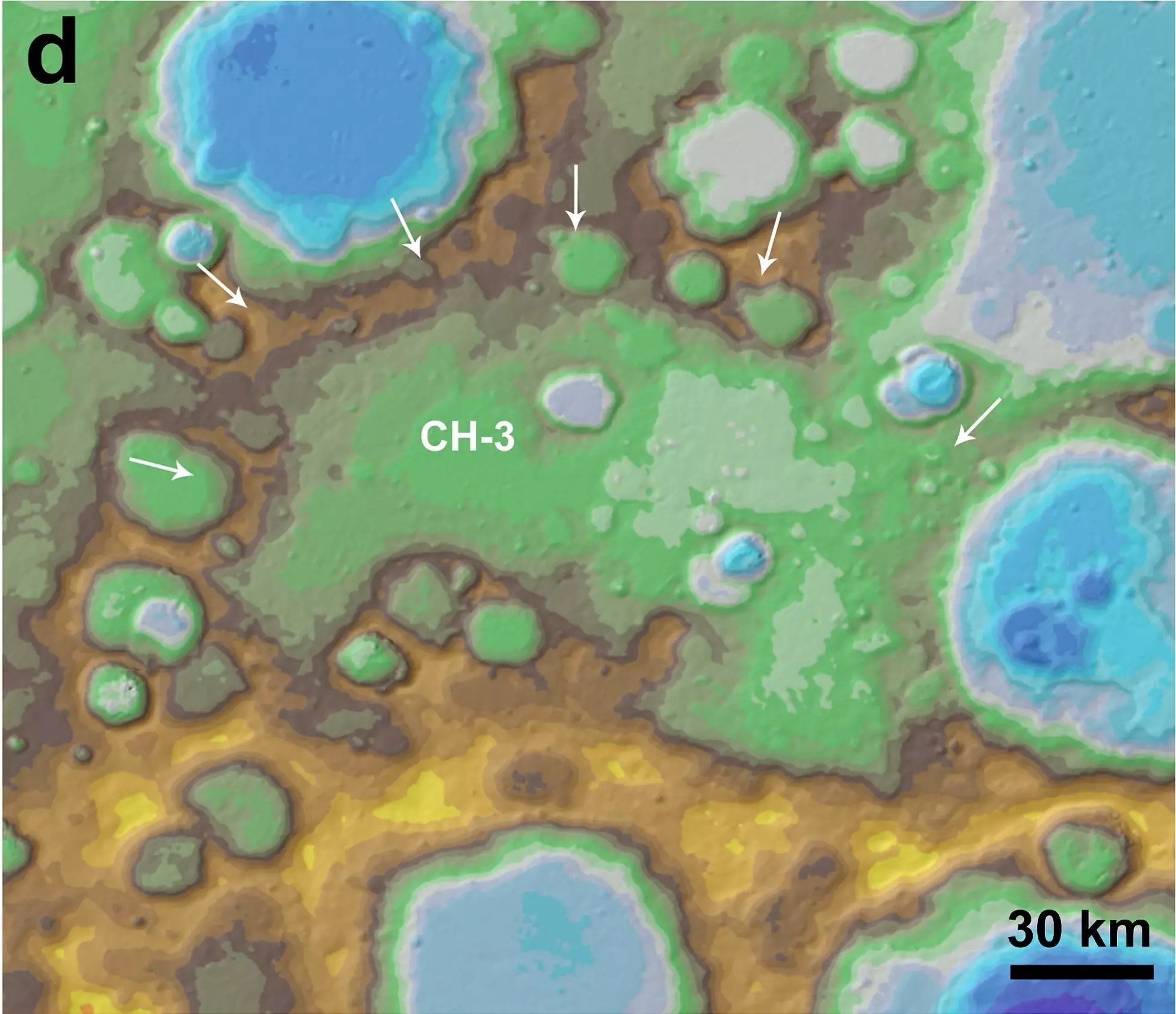
The partially degraded and buried semi-circular ancient crater can be seen in the above image.
“The older formation of these craters is one probable reason for their shallow depths and lack of boulders over the landing site region," researchers opined and added, "Overall, Chandrayaan-3 landed within an ancient region that hosts some of the most deeply excavated materials on the Moon."
